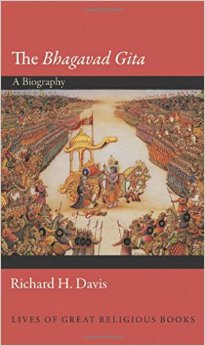The “Bhagavad Gita”: A Biography by Richard H. Davis
My rating: 5 of 5 stars
There have been many translations of the Bhagavad Gita, which is perhaps the most famous of all Indian scriptures, but this book is not one of them. Rather, Richard traces the journey of the Gita, from its oral renderings to when it appeared in written form…its different manifestations and interpretations…its journey from India to England and the States and Germany and then the rest of the world.
The book opens with the actual conversation between Lord Krishna and Arjuna; the dilemma Arjuna faces and how Krishna persuades him to engage in his duties, and in the process, teaches him the very essence of life itself. The author very deftly brings out various aspects of this conversation and lays the grounds for the subsequent chapters, where he connects these aspects to the the different interpretations of the Gita. A good portion of the book is dedicated to early manifestations of this text, following which he moves on to how the Gita left Indian shores through rudimentary translations by the British, who saw this scripture as a way to understand the Indian mindset. Richard then describes in detail the way Swami Vivekananda exploded onto the world scene at the Parliament of World Religions in 1893, thus introducing the teachings of the Gita to North America.
There are many aspects of the journey of the Gita that I was not aware of, for instance, the major role that it played in the Indian struggle for independence, both in the ahimsa movement spearheaded by Mahatma Gandhi and the revolutionary movement as well!
A book attempted on this scale has to be backed up by excellent research, and Richard does not disappoint, to say the least. From the very start, it is clear that the author has not only done his homework, but has done it well. He has combed through (by his own accounts) over 300 translations of the Gita and recommended four of them to those who wish to understand the diverse ways in which it can be interpreted. In the process, he manages to hold the interest of the reader and give the uninitiated a basic tour of Hinduism and its most important conversation. This is not a religious book; rather, it is a successful attempt in deconstructing the universal appeal of the message contained in the Bhagavad Gita.
This book could have easily become a mundane exercise in history; instead, it stands out as a beacon in the study of a timeless piece of literature. The role it played in the Indian freedom struggle, and what it means in todays life….its all there, well researched and written in a pleasant narrative. Read it!

